NumPy and Pandas are two of the most significant open-source data-science-oriented libraries of Python. If you want to perform complex data analysis, you must use Pandas and NumPy proficiently.
Normally, you can find great lessons on these two libraries in Python for Data Science courses. However, I understand that you may not have a chance to take them or still need extra assistance on these two advanced topics.
Thus, another crash course for NumPy and Pandas is desirable.
For transparency purposes, Victory Tale wants to notify every visitor that this post contains affiliate links.
This means the online platforms will give us a small commission when you purchase from our links. We will use this income to provide better and useful content for learners in the future.
Short Q&A About Learning NumPy and Pandas
I will provide a brief answer to several questions regarding NumPy and Pandas learning. You can skip this part if you want to.
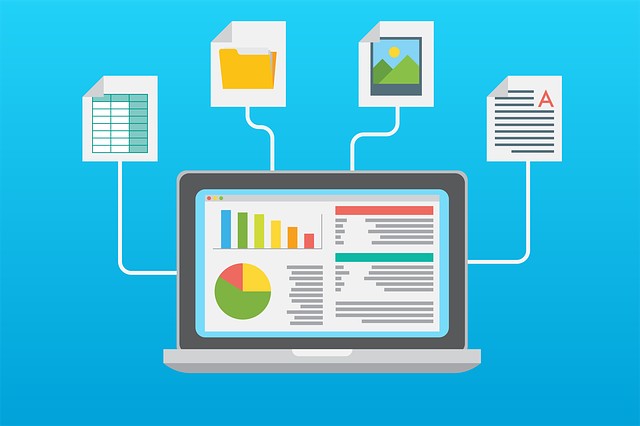
Q1: Are NumPy and Pandas hard to learn?
A: Yes and No. NumPy is quite easy to learn, but Pandas has a steep learning curve. Nevertheless, if you are familiar with Python up to a moderate level, you will be ok. A knowledge of high-school mathematics and statistics might be helpful.
Q2: Are NumPy and Pandas worth learning?
A: Sure! NumPy and Pandas are instrumental in performing data analysis in Python. Thus, they are vital in the data science field. Anyone who wants to pursue a data science career (data scientist, data analyst, and the like) needs to master these two Python libraries.
Q3: How can I learn NumPy and Pandas?
A: NumPy and Pandas communities provide great tutorials here and here, but the tutorials are less useful when analyzing a complex dataset.
Hence, I suggest you learn from the online courses below since it’s much easier to understand and could save you plenty of time.
Still, as a beginner, you will rely on documentation from an official site of NumPy and Pandas to help you along with the online courses, as they provide tons of information, including how to use a specific function and many more.
Q4: What are the prerequisites?
A: NumPy and Pandas are not for absolute beginners. You will need a knowledge of Python. Though you don’t need to be adept in Python as a Python developer, you should have at least a moderate understanding of the language.
2-3 Hours of Python tutorial without coding experience will not suffice unless you are so gifted or highly experienced in programming.
Hence, if you are a beginner, you should take Python courses beforehand.
Q5: What can you learn after Pandas?
A: Many options are available. For instance, you can start the journey of machine learning by learning the Scikit-Learn library or enter the world of data visualization by learning the Seaborn library. Tensorflow and Pytorch are interesting as well.
Best Online NumPy and Pandas Courses
Some learners might want to take crash courses. However, I would suggest taking detailed courses on NumPy and Pandas, as they are better alternatives.
A longer course would help you understand these two libraries by heart. Once you complete all the materials, your investments will pay off. You will comfortably use Pandas and NumPy like never before.
Therefore, most of the courses recommended here will be long and highly detailed, so please don’t expect to finish them in a few hours.
Important Notice:
- You should not compare the length of a Coursera course with the Udemy course indicated in this post. In Coursera, the length is approximately the aggregate time you spend to complete the course, but in Udemy, this is the video content’s total time. To complete a course in Udemy, you have to spend 3-4 times that of the course length.
- I have taken some courses on this list. There will be a “My Reviews” section on those.
1. Data Analysis with Python
In this course, you will learn NumPy, Pandas, and SciPy (an open-source library used in mathematics, science, and engineering) to perform data analysis in Python.
The creator is Joseph Santarcangelo, a data scientist at IBM, one of the leading companies in data science and AI technology.
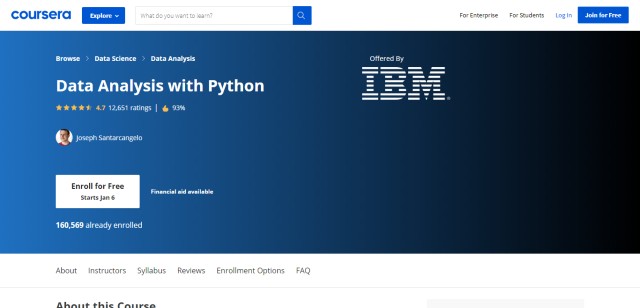
Topic Covered:
- Dealing with datasets: Import, manipulate, analyze, and visualize the datasets.
- Data Wrangling, Data Preprocessing, Data cleaning (such as dealing with missing values), Data Formatting, Data Normalization, and transforming categorical variables to quantitative ones.
- DataFrame Manipulation and Exploratory Data Analysis
- Building Machine Learning Models by using algorithms + Evaluation
Besides the lecture, you would be assigned several projects, exercises, and assignments. You may complete some of them in the IBM lab. This will flawlessly enhance your real-world skills as a data scientist.
This course is part of three professional certificate courses and specializations created by IBM. To gain the full experience of this course, you need to select and enroll in one of them.
I would suggest selecting IBM Data Science Professional Certificate or IBM Data Analyst Professional Certificate.
This is because a professional certificate course is more comprehensive than a specialization, as you have more classes to finish in the series. However, the monthly payment is the same ($39 per month).
On the other hand, you could audit the class for free (also true to other Coursera courses). Nevertheless, no one will grade your assignments. You will not receive certificates as well. In my opinion, this is a much inferior option, as you won’t know if you are on the right track or not.
Course Length: 25 Hours
Ratings: 4.7/5.0
You can experience the full course for free for 7 days.
2. Introduction to Data Science in Python
If you want to experience a university course on NumPy and Pandas on Coursera, Introduction to Data Science in Python by Christopher Brooks, a research assistant professor at the University of Michigan, is probably the best one I could find.
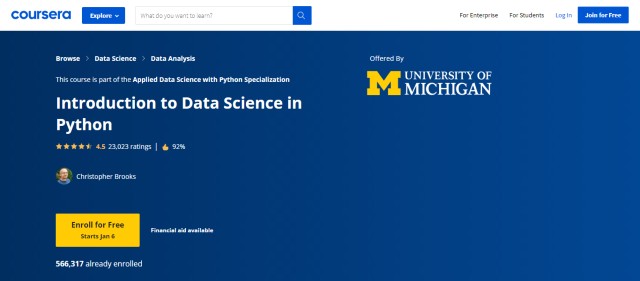
Topic Covered:
- Brief training on Python for learners to refresh their Python knowledge that will be needed for data science. You will learn about the development environment, types, functions, sequences, objects, and how to manage CSV files.
- The NumPy Library (Arrays, Indexing, etc.)
- Data Processing and Cleaning in Pandas – This includes Series, Dataframes, querying (both in Series and DataFrames), dealing with missing values, and DataFrames manipulation.
- How to merge multiple Pandas DataFrames, perform a Groupby operation, manipulate date and time
- Statistical Techniques and Data discovery
Compared to the IBM course, there will be fewer quizzes and practices, but you have many more great readings (similar to a typical college course.) Personally, I like to learn by doing, so the IBM course that provides hands-on experience suits me more, this is totally subjective though.
This course is also a part of the Applied Data Science Specialization offered by the University of Michigan. If you enroll in this course, you will be able to access other courses as well. The monthly payment is $49 per month.
3. The Complete Pandas Bootcamp 2022: Data Science with Python
Despite its name, this is probably one of the most comprehensive training NumPy and Pandas courses. You will learn from Alexander Hagmann, a data scientist who specializes in the financial industry.
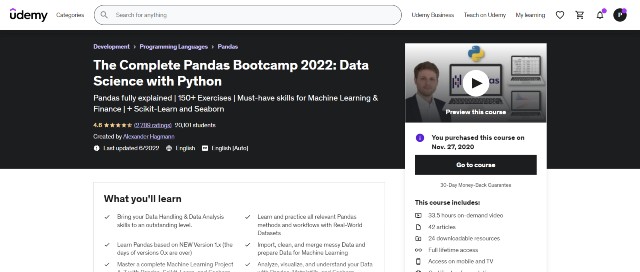
Topic Covered:
- Python Basics: A review of your knowledge of Python starting from the very beginning (from data types to conditionals, loops, and functions. )
- Statistical Concepts: A review of necessary statistical and mathematical concepts for learning Pandas and data analysis
- The NumPy Package: NumPy arrays, indexation, vectorization, slicing
- Pandas Basics (Exploring datasets, Selecting and slicing rows and columns with iloc)
- Creating and Analyzing Pandas Series
- Filtering DataFrames, Methods of adding and removing rows and columns
- Pandas DataFrame manipulation techniques
- Dealing with data issues: Importing, Cleaning, Merging, Joining, and Concatenating.
- GroupBy Operations
- Data Visualization by Matplotlib and Seaborn
- Pandas for Finance
- Building Machine Learning models with Pandas and Scikit-Learn
Reviews
I have already taken this course myself. These are my reflections:
Pros:
- As one of the most detailed and informative Pandas courses available online. Alexander explains everything in-depth and covers every major topic.
- There are numerous coding exercises and real-world projects for you to practice to excel in your skills. Each exercise is sorted from basics to advanced, which is very beginner-friendly.
- Alexander also provides one of the best lessons for learners to review Python and statistics.
- Great downloadable resources and materials with lots of information overall.
Cons:
- Alexander has an accent (German, I guess). Sometimes I can’t understand clearly what he says, but this does not occur that frequently.
- His pace is quite slow, which is great for a beginner but not for an experienced programmer. If you know parts of the material well, you might want to play videos at faster speeds (1.5x is optimal for me)
To summarize, learning NumPy and Pandas from Alexander was a wonderful experience. I really like his way of teaching. I am certain that you won’t be disappointed.
Course Length: 33.5 Hours
Ratings: 4.6/5.0
Students: 14800+
4. Data Analysis with Pandas and Python
This is a solid alternative to Alexander’s course. You will be taught by Boris Paskhaver, an NYC-based software engineer and a data scientist. As of January 2021, this is the most popular Pandas course in Udemy.
Unlike other courses, Boris will only teach data analysis with the Pandas library. NumPy will not be mentioned. You might need to learn NumPy elsewhere or open the documentation, if necessary.
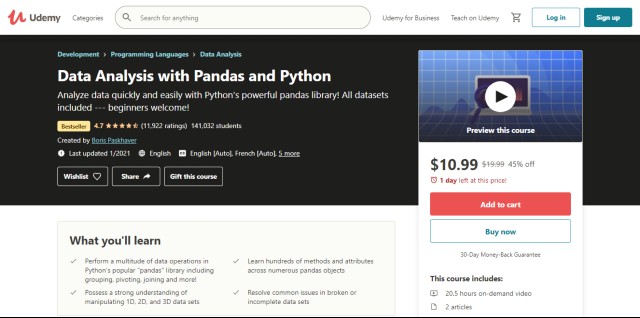
Topic Covered
- Python crash course: A review of basic Python concepts, such as variables, lists, dictionaries, loops
- Deep dive on series: Create a Series object from Python lists, dictionaries, and multiple datasets. You will also use several methods on Series, such as idxmax or idxmin.
- Introduction to DataFrame: You will know how to select and add a column on a DataFrame, deal with missing data in rows and sort the table as you wish.
- Filtering a DataFrame
- Data Extraction: You will learn how to retrieve and delete columns and rows, create a random sample, and many other methods, etc.
- Use Pandas to clean your text data
- DataFrame Optimization for Speed and Efficiency
- GroupBy Object
- Concatenate, Inner/Outer Joins, and merge DataFrames
- Work with dates and times using tools in the Pandas library
- Visualization
- and many more
Overall, this is more like an intensive course on Pandas. If you want to master the concepts, this is definitely one of the best options you could find.
The only downside that I see is the absence of a real-world project or exercises for learners. You will learn mostly by following the examples provided by the instructor.
Course Length: 20.5 Hours
Ratings: 4.7/5.0
Students: 149,000+
5. Data Manipulation in Python: A Pandas Crash Course
For those who want a crash course for the Pandas library, you might be interested in this Udemy course. Compared to others in this list, this online class is very brief (9 hours of content.) It concisely covers the essence of the Pandas library but has no NumPy content.
You will learn with 3 instructors from the SuperDataScience Team. They are all talented data scientists with decades of experience in total.
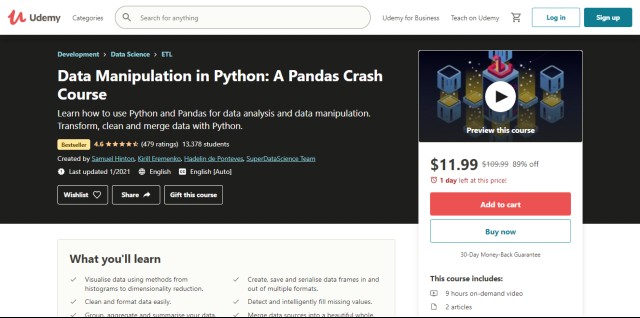
Topic Covered:
- Dataset Basics (Creating and Inspecting DataFrames)
- Visual Exploration (Using Pandas and Matplotlib)
- Data Manipulation methods such as slicing, filtering, replacing, removing, and adding data.
- Grouping and merging
- Advanced Data Manipulation methods: MultiIndex, Pivoting, Stacking
- Time Series Data
- and many more
This video class is equipped with a cheatsheet and several exercises based on real-world examples. It would be best if you used them to enhance your skills.
Many reviewers point out that the pace is too fast. This course is not suitable for a beginner, despite its name.
Ratings: 4.6/5.0
Students: 32400+
6. The Ultimate Pandas Bootcamp: Advanced Python Data Analysis
Another solid contender from Udemy, Andy Bek, a software developer, created this 32-hour video class to instruct every beginner to understand Pandas by heart.
Andy even notes that you don’t need any Python knowledge to start learning. This might be the case for some. In fact, you can try his “rapid-fire” training first, if you have a problem, you should take the Python fundamental course and come back here later.
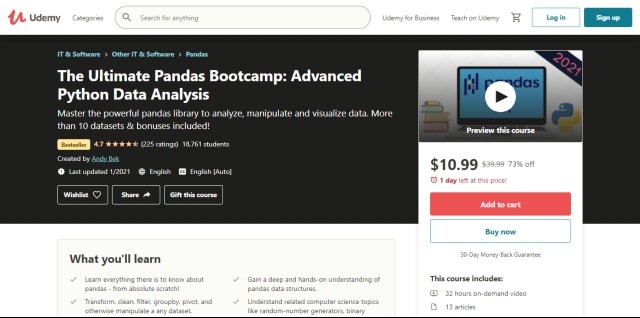
Topic Covered:
- Introduction + NumPy in 12 minutes
- A deep dive on Series
- Building Pandas DataFrame, Data Cleanup, DataFrame sorting and other methods
- Removing Duplicates, Setting DataFrame values, Adding columns
- Working with multiple DataFrames (Concatenate, Merge, Joins)
- Dealing with multidimensional arrays
- GroupBy and Aggregates
- Handling Date and Time
- Regex and Text Manipulation (String methods in Python, String Splitting, etc.)
- Visualization of data using Matplotlib
- Python Review
- and many more
You will use real-world data to perform data analysis throughout this course. This includes SAT Scores, video game sales, stock prices, etc.
In total, you will work with more than 10 data sets. You will clearly recognize how data scientists are using Pandas in real life. This is probably the greatest strength of this course that you can’t ignore.
Furthermore, Andy provides many skill challenges and exercises for you to solve. Each of them comes with a detailed solution so that you can master the Pandas library with ease in a quick way.
Ratings: 4.7/5.0
Students: 19400+
Tip: Coursera Plus

If you are interested in more than one course or specialization in Coursera, I recommend you subscribe to Coursera Plus for a year. The subscription will cost $399 a year ($33.25 per month on average) but yields much more benefits to learners.
- Full Access to 3,000 courses, specializations, professional certificate courses, and guided projects. Thus, you are free to take any course to improve your skills as you wish.
- Cheaper than a normal subscription, which is $39-$79 a month
- No need to worry about the monthly payment because everything is now all-inclusive.
However, as of July 2022, Coursera offers a monthly subscription to Coursera Plus at $59 a month. I don’t believe you should take this offer, since the pricing is too high (almost twice the yearly subscription).
You can try this service for free for 14 days.
[sc name=”coursera” ][/sc]